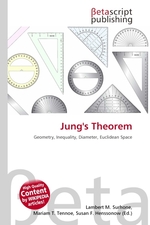Jungs Theorem
Lambert M. Surhone, Mariam T. Tennoe, Susan F. Henssonow
бумажная книга
High Quality Content by WIKIPEDIA articles! In geometry, Jung's theorem is an inequality between the diameter of a set of points in any Euclidean space and the radius of the minimum enclosing ball of that set. It is named after Heinrich Jung, who first studied this inequality in 1901.For any bounded set S in any metric space, d/2 ? r ? d. The first inequality is implied by the triangle inequality for the center of the ball and the two diametral points, and the second inequality follows since a ball of radius d centered at any point of S will contain all of S. In a uniform metric space, that is, a space in which all distances are equal, r = d. At the other end of the spectrum, in an injective metric space such as the Manhattan distance in the plane, r = d/2: any two closed balls of radius d/2 centered at points of S have a nonempty intersection, therefore all such balls have a common intersection, and a radius d/2 ball centered at a point of this intersection contains all of S. Versions of Jung's theorem for various non-Euclidean geometries are also known (see e.g. Dekster 1995, 1997).
Данное издание не является оригинальным. Книга печатается по технологии принт-он-деманд после получения заказа.


